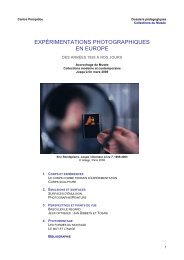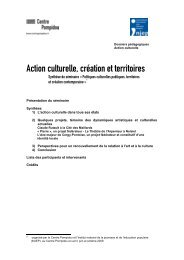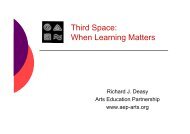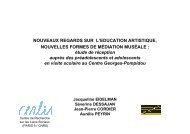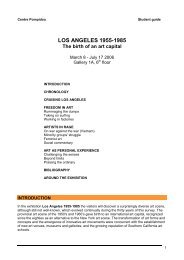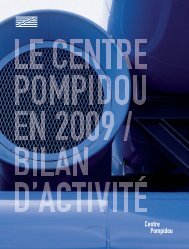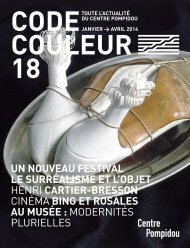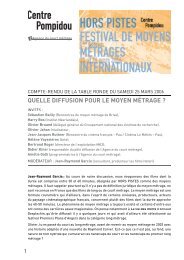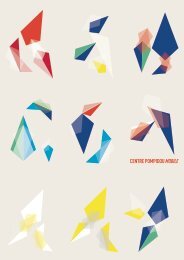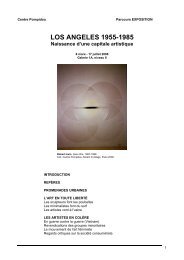to download the PowerPoint presentation - Centre Pompidou
to download the PowerPoint presentation - Centre Pompidou
to download the PowerPoint presentation - Centre Pompidou
You also want an ePaper? Increase the reach of your titles
YUMPU automatically turns print PDFs into web optimized ePapers that Google loves.
Program overview and research highlights<br />
Shari Tishman & Patricia Palmer<br />
Harvard Project Zero
Artful Thinking…<br />
• Focuses on looking at and interpreting art, ra<strong>the</strong>r<br />
than making art.<br />
• Used by K-12 classroom teachers in all subject areas,<br />
as well as by art specialists.<br />
• Two goals: (1) To help teachers create rich<br />
connections between works of art and <strong>to</strong>pics <strong>the</strong>y are<br />
teaching; (2) <strong>to</strong> use <strong>the</strong> power of art as a force for<br />
developing students’ thinking dispositions.
3 Key Elements<br />
1. thinking dispositions<br />
2. Thinking routines<br />
3. Art & curricular connections
Research background: The triadic<br />
<strong>the</strong>ory of dispositions<br />
Ability<br />
Sensitivity<br />
Inclination
Which thinking dispositions
Reasoning<br />
Questioning & Investigating<br />
Observing & Describing<br />
Exploring Viewpoints<br />
Finding Complexity<br />
Comparing & Connecting
How do dispositions develop<br />
By routinely engaging in specific<br />
patterns of behavior – by doing<br />
certain things regularly
Thinking Routines<br />
Short, easy-<strong>to</strong>-learn procedures that<br />
help students engage in thinkingdispositional<br />
behavior in and across <strong>the</strong><br />
six areas of <strong>the</strong> palette
Reasoning<br />
Claim-Support-Question<br />
Questioning &<br />
Investigating<br />
Observing & Describing<br />
•Make a claim about <strong>the</strong> artwork or <strong>to</strong>pic<br />
•Identify support for your claim<br />
•Ask a question related <strong>to</strong> your claim<br />
See-Think-Wonder<br />
•What do you see<br />
•What do you think about that<br />
•What does it make you wonder
Sample curricular connections<br />
• Plants<br />
• Population density<br />
• Colonial America<br />
• Humor in Language<br />
Arts<br />
• Genetics
Conceptual Change: 2 Studies<br />
• Students’ and teachers’ concepts of<br />
art<br />
• Students’ concepts of thinking
Concepts of Art<br />
“I used <strong>to</strong> think…”<br />
“Now I think…”<br />
2 groups:<br />
• 85 students (5 th, 6 th 9 th<br />
grade)<br />
• 26 teachers
Student Shift<br />
I USED TO THINK…<br />
Art is not engaging<br />
NOW I THINK…<br />
Art invites inquiry<br />
I thought when you looked at a<br />
painting or a sculpture what you saw<br />
was <strong>the</strong> whole picture and nothing was<br />
<strong>the</strong> center of interest or thought<br />
provoking (10)<br />
I used <strong>to</strong> not pay attention <strong>to</strong> detail<br />
and <strong>the</strong> mood of <strong>the</strong> artwork or music.<br />
I would look at <strong>the</strong> artwork<br />
superficially, only paying attention <strong>to</strong><br />
what was right in front of my face such<br />
as <strong>the</strong> color. I never delved deeper<br />
in<strong>to</strong> what <strong>the</strong> artist was trying <strong>to</strong> get<br />
across. (14)<br />
Art can have many questions in it<br />
(10)<br />
Art is very complex and <strong>the</strong>re are a<br />
lot of observations you can make<br />
and <strong>the</strong>re are a lot of view points in<br />
art (11)<br />
Now I think that every picture or song<br />
has a message, a hidden meaning,<br />
that exists within <strong>the</strong> pictures. You<br />
just have <strong>to</strong> take <strong>the</strong> time <strong>to</strong> find<br />
it….It’s not just a picture it’s a symbol<br />
for something more. (14)
Teacher Shifts: Art and <strong>the</strong> curriculum<br />
USED TO THINK…<br />
Art is not centrally<br />
connected <strong>to</strong> <strong>the</strong> curriculum<br />
Art is just for art class<br />
Art is motivational or<br />
instrumental<br />
NOW I THINK….<br />
Art connects meaningfully<br />
<strong>to</strong> <strong>the</strong> curriculum<br />
Art helps students think<br />
and learn<br />
I used <strong>to</strong> think that it was <strong>the</strong> art teacher’s responsibility <strong>to</strong> expose students <strong>to</strong> art.<br />
Now I think richer more-in-depth discussions result when using art as opposed <strong>to</strong><br />
not.<br />
I used <strong>to</strong> think it had <strong>to</strong>ken use- nice but not truly useful. Now I think I can help<br />
students think more deeply, ask more questions, understand connections, and<br />
deepen knowledge.
Broad characterization of conceptual shifts,<br />
students and teachers<br />
Art is… simple, one-dimensional, bounded, “o<strong>the</strong>r”<br />
Art is… Complex, multi-dimensional, has multiple<br />
meanings and contexts, cognitive, personal, integrated
Student Concept Maps
Student Concept Maps<br />
Quasi-experimental<br />
design N= 359<br />
Concept map used 3<br />
times over 1.5 years<br />
3 groups (in both<br />
experimental and<br />
control): 4th-6th grade
Constructed map, representing all main<br />
categories<br />
When I learn it is<br />
easier <strong>to</strong> think<br />
Organize my<br />
thoughts on a<br />
piece of paper<br />
I sit in a quiet<br />
place <strong>to</strong> help<br />
me think better<br />
Good<br />
thinking<br />
I think about<br />
science<br />
Talk it over<br />
with a friend<br />
If you don’t know<br />
<strong>the</strong> answer ask<br />
<strong>the</strong> teacher<br />
Read <strong>the</strong><br />
directions<br />
Palette-related<br />
thinking
• Observing & describing: Make<br />
observations; use words <strong>to</strong> describe.<br />
• Reasoning: I see if my answer is<br />
reasonable; see if I can find a way <strong>to</strong><br />
prove it<br />
• Questioning & investigating: Ask<br />
questions; [ask] what you wonder.<br />
• Comparing & Connecting: Think of<br />
something similar; compare<br />
something; think about past<br />
experiences.<br />
• Exploring viewpoints: I look at it in<br />
different ways; Always think of a<br />
different way of putting it. I think how it<br />
felt <strong>the</strong>n.<br />
• Exploring complexity: Break <strong>the</strong><br />
sentence down; break in<strong>to</strong> sections;<br />
Take little ideas and make it in<strong>to</strong> a<br />
bigger one<br />
• Multi-palette: Explain your thinking,<br />
try different ways <strong>to</strong> figure out <strong>the</strong><br />
question, Think about brains<strong>to</strong>rming <strong>to</strong><br />
explore different answers<br />
Palette-related<br />
thinking
Total palette: Natural development<br />
Total Palette (Natural Development)<br />
2.5<br />
2<br />
Average<br />
1.5<br />
1<br />
0.5<br />
0<br />
0 1 2 3 4 5<br />
-0.5<br />
GL<br />
Data Point
Comparative: 4 th , 4 th , 5 th<br />
Total Palette (Group 1: grade 4,4,5)<br />
6<br />
5<br />
4<br />
3<br />
2<br />
1<br />
GL<br />
LL<br />
0<br />
-1<br />
0 1 2 3 4 5<br />
Data Point
Comparative: 5 th , 5 th , 6 th<br />
Total Palette (Group 2: grade 5,5,6)<br />
5<br />
4<br />
3<br />
2<br />
1<br />
GL<br />
LL<br />
0<br />
-1<br />
0 1 2 3 4 5<br />
Data Point
Comparative: 6 th , 6 th<br />
Total Palette (Group 3: grade 6,6)<br />
4.5<br />
4<br />
3.5<br />
3<br />
2.5<br />
2<br />
1.5<br />
1<br />
0.5<br />
0<br />
-0.5<br />
0 1 2 3 4 5<br />
Data Point<br />
GL<br />
LL
Key Points<br />
• Both groups have a robust variety of ideas about<br />
good thinking<br />
• Both groups have some palette-related ideas:<br />
shows that palette is “natural.”<br />
• AT seems <strong>to</strong> dramatically accelerate paletterelated<br />
ideas early on, <strong>the</strong>n may level off.<br />
• Concept maps an indication of cognitive<br />
sensitivity ra<strong>the</strong>r than ability
Looking across <strong>the</strong> 2 studies<br />
• No big surprises. Evaluation activities should<br />
maintain a close connection <strong>to</strong> <strong>the</strong> goals of a<br />
program.<br />
• “Impact” is likely increased with a deep, rich, and<br />
expansive conception of art, along with<br />
instructional approaches that that let artworks<br />
“work.”
“Now in class when we look at art …<br />
we think more specifically and really<br />
discover what this artwork makes us<br />
feel and want <strong>to</strong> know and learn.” (age<br />
11)
http://www.pz.harvard.edu/at<br />
For curriculum connections:<br />
http://www.pz.harvard.edu/at/cc_intro3.cfm



